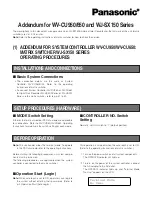
21
RS232 CONTROL
Remote Connection
The RS232 Interface is designed to meet the RS232C standard and can be controlled from any host CPU or other controller with
an RS232 communications port. The pin-out for the DB-9 connector(s) on the unit is as follows:
RS232 INPUT (DB-9 FEMALE)
RS232 OUTPUT (DB-9 MALE)
PIN
SIGNAL
FUNCTION
PIN
SIGNAL
FUNCTION
1
CD
Carrier Detect
1
-
No connection
2
TXD
Transmit data (RXD at host)
2
RXD
Receive data
3
RXD
Receive data (TXD at host)
3
TXD
Transmit data
4
DTR
Data terminal ready
4
-
No connection
5
GND
Signal ground
5
GND
Signal ground
6
DSR
Data set ready
6
-
No connection
7
RTS
Request to send
7
-
No connection
8
CTS
Clear to send
8
-
No connection
9
-
No connection
9
-
No connection
NOTE: Security must be disabled or user access granted on the port(s) to be selected by RS-232 control.
On the DB-9 female connector, pins 1 (DCD), 4 (DTR), and 6 (DSR) are shorted and pins 7 (RTS) and 8 (CTS) are shorted.
Therefore, host handshaking is bypassed and TXD and RXD are the only active signals. A straight through DB-9 cable (not null
modem) will work for most CPUs. To daisy chain multiple units, the CPU drives the input port on the first unit and the output port of
the first unit is connected to the input port on the next unit etc. The last unit will have a loop back plug installed in its RS232 OUT
connector.
Baud Rate
The baud rate can be changed by selecting MENU on the front panel keypad. Then select 1 for SET BAUD RATE and select the
desired baud rate of 9600, 2400, 1200, or 300. A data protocol of 8 data bits, no parity, and 1 stop bit is used for communications.
Unit Address and Loop Back
To allow multiple units to be controlled from a single host port, the RS232 control interface is designed to allow "daisy chaining" up
to 15 units. By setting the appropriate unit address with the keypad, each unit can be given a unique address (1-15). Then the unit
will only respond to commands on the bus if its address is embedded in the command.
To set the unit address;
1. select MENU on the front panel keypad,
2. select 2 for SET UNIT ADDRESS,
3. type the address number (1-15),
4. press <ENTER> on the front panel keypad.
The "loop back" plug should be on the RS232 OUT connector on the last unit in the chain. If only one unit is being controlled, the
loop back plug should be on the RS232 OUT connector on that unit. (See Fig. 19)
Fig. 19
Summary of Contents for ST-nXm-USBV-U
Page 22: ...20 Fig 19 Fig 18...






































